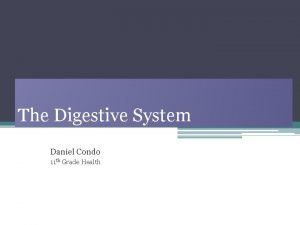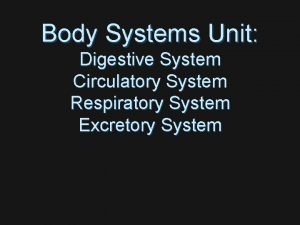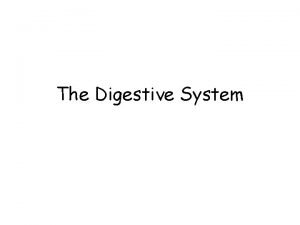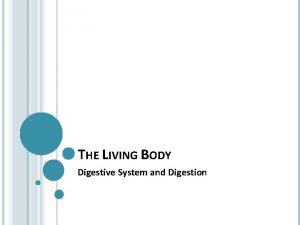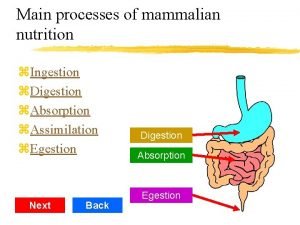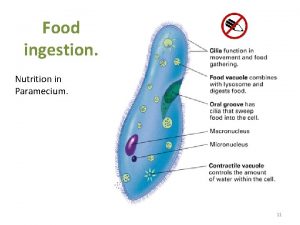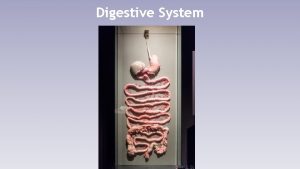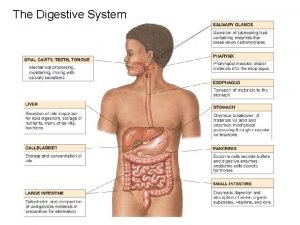Digestive System Purpose 1 Ingestion Take food in













- Slides: 13

Digestive System

Purpose: 1. Ingestion: Take food in 2. Digestion: Break down food • • Physically by chewing Chemically through reactions and acids 3. Absorption: Nutrients move into the blood 4. Elimination: Waste passes out of the system

ORGANS INVOLVED IN DIGESTION em t s y ve s wing i t s ige follo d r ou th the y l e i Lab ram w abels l diag

Tissues • The entire digestive tract is lined with epithelial tissue that secretes mucus • Functions of mucus: – Protects tissue from digestive enzymes – Allows material to pass smoothly along tube

Did you know? If you eat spoiled food, your body recognizes the presence of toxins and attempts to remove as quickly as possible. You experience this as vomiting or diarrhea.

Mouth • Mechanical digestion – Breaks food down by chewing • Chemical digestion – Enzymes in saliva break down molecules of food

Esophagus • Muscular tube connecting mouth and stomach • Smooth muscle tissue: can contract with conscious thought

Stomach • Mechanical Digestion – Stomach churns food • Chemical Digestion – Very strong acid (p. H 2) – Digestive enzymes • Contains many nerves that tell us when we’re full

Did you know? • Heartburn occurs when stomach acid backs up into your esophagus • Your esophagus does not have thick mucous layer that protects your stomach and this results in a burning sensation • Treatment can include taking an antacid to neutralize the acid

Small Intestine • • 6 m long and 1. 5 cm in diameter Site of most digestion Goblet cells secrete mucous Nutrients diffuse through the wall of the small intestine into the bloodstream

Large Intestine • 1. 5 m long and 6 cm in diameter • Absorbs water from indigestible food • Remaining solid matter is excreted as feces from the anus

Accessory Organs • Liver – Secretes bile which helps to emulsify fats • Gallbladder – Stores bile • Pancreas – Produces insulin which regulates the concentration of glucose in the blood

 Digestive system of human diagram
Digestive system of human diagram On digestion
On digestion Function of body in stomach
Function of body in stomach Function of ingestion
Function of ingestion Digestive system circulatory system and respiratory system
Digestive system circulatory system and respiratory system Mouth function in digestion
Mouth function in digestion Path of food from mouth to anus
Path of food from mouth to anus Ingestion and digestion
Ingestion and digestion Haustra of colon
Haustra of colon Metadata driven ingestion framework
Metadata driven ingestion framework Passenger management system
Passenger management system Oesogastrectomie par stripping
Oesogastrectomie par stripping Fat test
Fat test Process of ingestion
Process of ingestion

